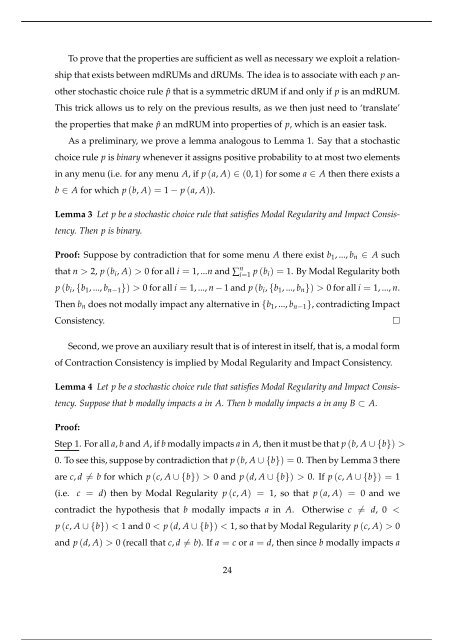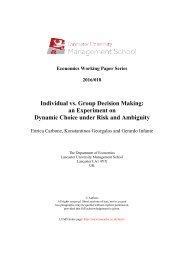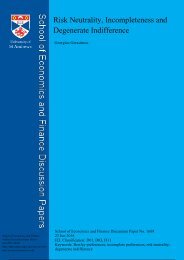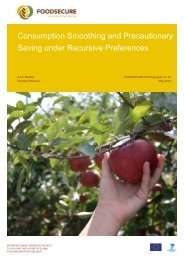Dual Random Utility Maximisation
n?u=RePEc:san:wpecon:1605&r=upt
n?u=RePEc:san:wpecon:1605&r=upt
Create successful ePaper yourself
Turn your PDF publications into a flip-book with our unique Google optimized e-Paper software.
To prove that the properties are sufficient as well as necessary we exploit a relationship<br />
that exists between mdRUMs and dRUMs. The idea is to associate with each p another<br />
stochastic choice rule ˆp that is a symmetric dRUM if and only if p is an mdRUM.<br />
This trick allows us to rely on the previous results, as we then just need to ‘translate’<br />
the properties that make ˆp an mdRUM into properties of p, which is an easier task.<br />
As a preliminary, we prove a lemma analogous to Lemma 1. Say that a stochastic<br />
choice rule p is binary whenever it assigns positive probability to at most two elements<br />
in any menu (i.e. for any menu A, if p (a, A) ∈ (0, 1) for some a ∈ A then there exists a<br />
b ∈ A for which p (b, A) = 1 − p (a, A)).<br />
Lemma 3 Let p be a stochastic choice rule that satisfies Modal Regularity and Impact Consistency.<br />
Then p is binary.<br />
Proof: Suppose by contradiction that for some menu A there exist b 1 , ..., b n ∈ A such<br />
that n > 2, p (b i , A) > 0 for all i = 1, ...n and ∑i=1 n p (b i) = 1. By Modal Regularity both<br />
p (b i , {b 1 , ..., b n−1 }) > 0 for all i = 1, ..., n − 1 and p (b i , {b 1 , ..., b n }) > 0 for all i = 1, ..., n.<br />
Then b n does not modally impact any alternative in {b 1 , ..., b n−1 }, contradicting Impact<br />
Consistency.<br />
□<br />
Second, we prove an auxiliary result that is of interest in itself, that is, a modal form<br />
of Contraction Consistency is implied by Modal Regularity and Impact Consistency.<br />
Lemma 4 Let p be a stochastic choice rule that satisfies Modal Regularity and Impact Consistency.<br />
Suppose that b modally impacts a in A. Then b modally impacts a in any B ⊂ A.<br />
Proof:<br />
Step 1. For all a, b and A, if b modally impacts a in A, then it must be that p (b, A ∪ {b}) ><br />
0. To see this, suppose by contradiction that p (b, A ∪ {b}) = 0. Then by Lemma 3 there<br />
are c, d ̸= b for which p (c, A ∪ {b}) > 0 and p (d, A ∪ {b}) > 0. If p (c, A ∪ {b}) = 1<br />
(i.e. c = d) then by Modal Regularity p (c, A) = 1, so that p (a, A) = 0 and we<br />
contradict the hypothesis that b modally impacts a in A. Otherwise c ̸= d, 0 <<br />
p (c, A ∪ {b}) < 1 and 0 < p (d, A ∪ {b}) < 1, so that by Modal Regularity p (c, A) > 0<br />
and p (d, A) > 0 (recall that c, d ̸= b). If a = c or a = d, then since b modally impacts a<br />
24






